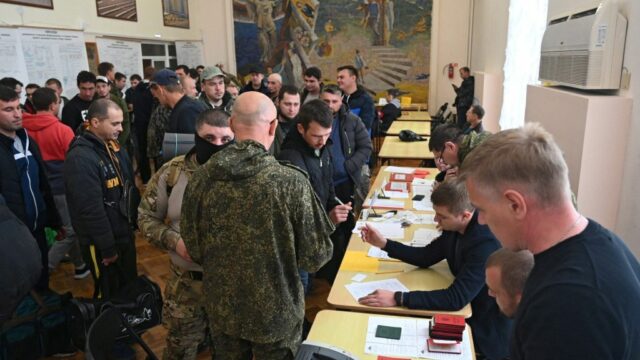
Mobilization as a Triumph of Political Eschatology
Publication: Eurasia Daily Monitor Volume: 19 Issue: 144
By:

The first week of the “partial mobilization” in Russia, which started on September 21, has demonstrated rampant bureaucratic chaos, a lack of planning and a deficit of training facilities and even basic equipment (72.ru, September 26; Kommersant, September 27; Sekret Firmy, September 28; Ura.ru, September 29; RIATomsk.ru, September 29). Although the mobilization does not have any clear schedule, it is possible to presume that the first wave of this process will be completed by October 1, as fall conscription for 2022 is starting on that day. In this way, it would be hard for the recruitment centers—the military commissar’s offices—to combine two processes simultaneously, considering that the planned quota for the upcoming conscription is 120,000 recruits (59.ru, September 29; Gazeta.ru, September 28).
Currently, the total number of people who have already been mobilized is estimated at anywhere from several tens of thousands to less than 100,000. This range is based on fragmentary data from different regions of Russia and will be updated as new information appears (Ura.news, September 23; Business-class.su, September 27; Kostroma.today, September 27; Regnum.ru, September 27; Bfm.ru, September 28). Nevertheless, even high-end estimates are definitely far off from the announced 300,000 reservists planned to be mobilized (Interfax, September 21), despite the fact that local recruitment centers are mobilizing everyone they can, including those who formally cannot be mobilized at all (Kommersant, September 24; 63.ru, September 27). That means that further waves of mobilization are inevitable within the current political circumstances, and the Kremlin may even try to combine future waves with fall conscription, thus infusing more chaos into the recruiting process, regional governance and economy, especially if the combat situation continues to worsen for Russia. That also means that future efforts toward mobilization will involve increased government coercion.
However, if young Russians will try to avoid the upcoming conscription as they did during the spring of 2022, the mobilization will most likely become a permanent, but less intensive, process that will be extended for months (Riddle, August 19). For instance, some evidences indicates that Russian public service centers have been unofficially ordered to give men between the ages of 20 and 34 their mobilization draft notices (Forbes.ru, September 29). Consequently, the Kremlin is searching for any possible way to increase its manpower significantly in the short term.
Interestingly, the mobilized Russians receive the status of contracted soldiers, therefore, they are forced to sign a contract. In this way, they are becoming volunteer military de jure. That means the Kremlin is trying to share the war’s responsibility with them and to prevent their probable consolidation into anti-Kremlin and anti-war sentiments. Moreover, together with the current contracted soldiers and non-commissioned officers (NCOs), the mobilized Russians cannot retire from the armed forces before Moscow grants approval.
At the same time, the “partial mobilization,” which almost inevitably will transform into a permanent mobilization, requires an economic mobilization with further restoration of an administrative-command economy. And today, Russian defense itself is not ready to fill the needs of the armed forces (Kremlin.ru, September 20). However, it does not matter whether the Russian leadership will start such a mobilization, because the Russian economy is growing increasingly unstable and many economic decisions will only serve to worsen the situation. The mobilization of personnel itself is damaging civil economic activity. It increases turbulence in the labor market and decreases consumer demand (Kommersant, September 28; Forbes.ru, September 28). Consequently, further troubles with sustainability in the Russian political-economic system are inevitable too.
The Russian people’s reaction to mobilization has been varied, but no significant support of this process is apparent at all. Those who are disoriented, demoralized and scared are choosing between passive submission and even fatalism on the one hand, and an escape, on the other. However, the window of opportunity for escape is closing fast, and if more than 260,000 military-age men have fled Russia during the initial days of mobilization (Novaya gazeta, September 25), this flow will certainly decrease as neighboring states are closing their borders to Russians citizens and the Russian authorities are trying to prevent more men from escaping (Fontanka.ru, September 28). As a result, the resistance to the mobilization presumably will continue to grow in coming weeks.
In this way, the Kremlin is trying to use a political psychology approach, mixing toughness with a relative meltdown in its policy. In 1930, Joseph Stalin, in the article “Dizzy With Success,” criticized overbearing toughness during collectivization. In this light, Russian propagandists and state-owned media are criticizing the overzealous local bureaucracies, which are mobilizing the wrong people (Federal Press, September 28; Rutube.ru, September 28).
However, one of the biggest social problems in Russia right now in relation to the mobilization is a growing political eschatology among the Russian people: They consider the war in Ukraine as the ultimate confrontation between Moscow and the West for the survival of the Russian state at all costs. Trying to relieve their cognitive dissonance in the face of the illegal war, growing economic turbulence and mobilization, many Russians spread the thesis that the Russian army in Ukraine is fighting directly against North Atlantic Treaty Organization (NATO) forces and that this war has been inevitable since 1991—when, according to the myth, the Soviet Union collapsed mainly due to Western influence operations and not interim political, economic and societal factors. The Kremlin has created this thesis and maintains it, but growing sectarian thinking in Russian society does not mean a consolidation around the flag but rather poses a threat of further societal fragmentation and even the eventual decay of the Russian state (Kremlin.ru, September 21).



